Written by Brent Huntley in ATVs
My wife would claim I am the most forgetful person there is, and this has included the unfortunate forgetting of ATV ramps. While it can be a bit panic-inducing to realize you have made it somewhere and don’t have ramps to unload and reload your ATV into your truck, it really isn’t a big deal in most situations. I had someone teach me an easy way to load an ATV and thought it was worth passing on, along with another easy way I have used when available that is easier than ramps.
How do you load an ATV without ramps? If you have an elevated surface you can just back the truck into it and drive the ATV in. If you do not have such a surface, you can pop up the front of the ATV and roll the front wheels onto the tailgate before lifting the back end.
These methods sound pretty easy, and they are, but you are dealing with a heavy piece of equipment and there are some things that go wrong. We want to make sure you get your ATV to the trail for an awesome day of riding with no damage to your truck, your ATV or your body, so we detail out the processes step-by-step below. You may also want to check out our guide for nearly every truck bed to see how well your ATV will fit.
Lifting the ATV End by End
This method requires you to do a fair amount of heavy lifting. How heavy depends on the weight of your ATV. If you are getting up around 500cc or higher with a utility ATV like the Polaris Sportsman (pretty consistently the heaviest model in its cc class I could find). If you have a lighter sports model, even something like a 700cc Yamaha Raptor, and this should work great for you. Even a 300-400 pound quad may sound heavy, but it isn’t bad since you only lift one side at a time.
To lift your quad into a truck bed, just follow these detailed steps exactly to keep your ATV, truck and body safe.
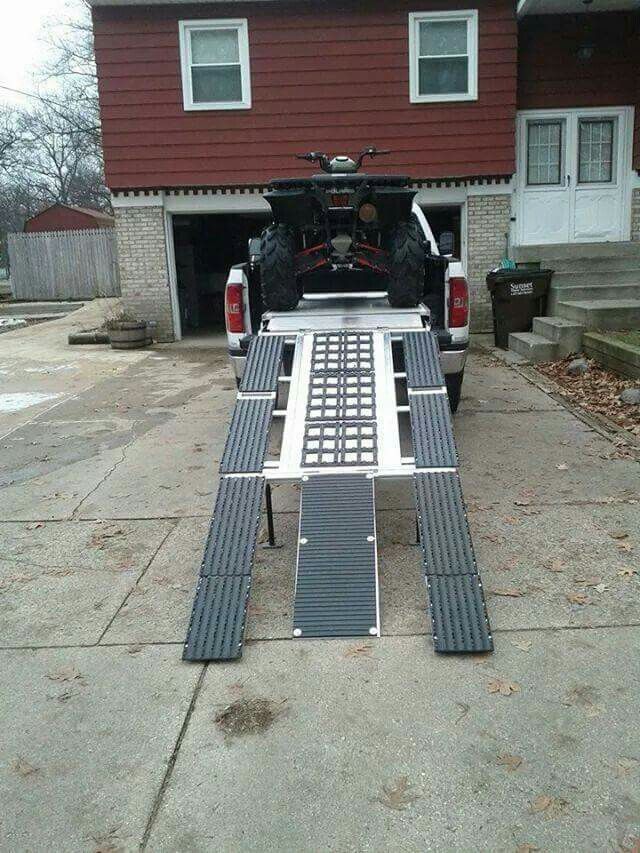
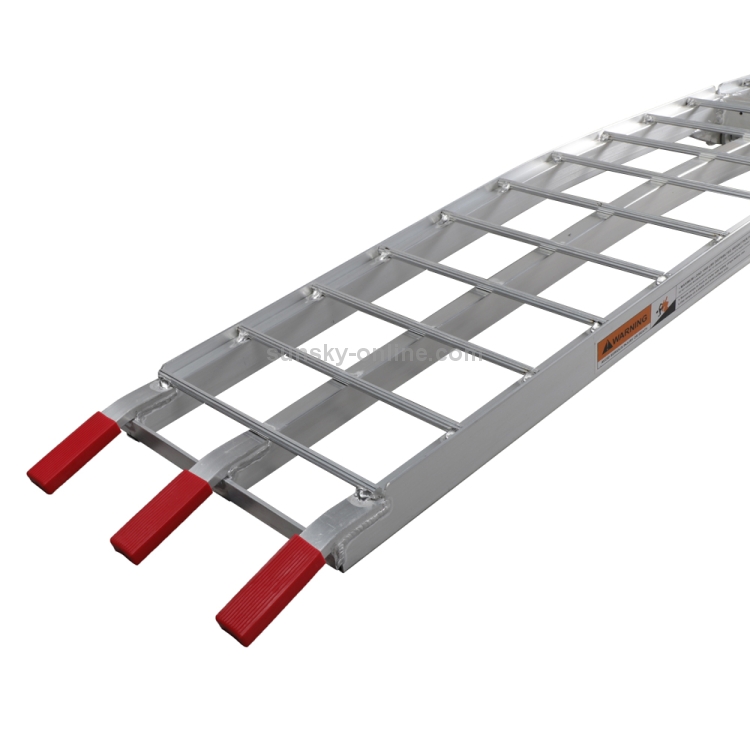 Make sure you lift with your legs and keep your back straight.
Make sure you lift with your legs and keep your back straight.That may have seemed like a lot of steps, but it shouldn’t take you more than a few minutes to easily get your ATV in your truck bed, if it isn’t too heavy, without the use of any ramps.
This may not be an option for everyone, but it makes it really simple to load an ATV into a truck bed if you have some kind of elevated surface to back your truck into. This could be a hill, a slanted driveway, a loading dock or many other things.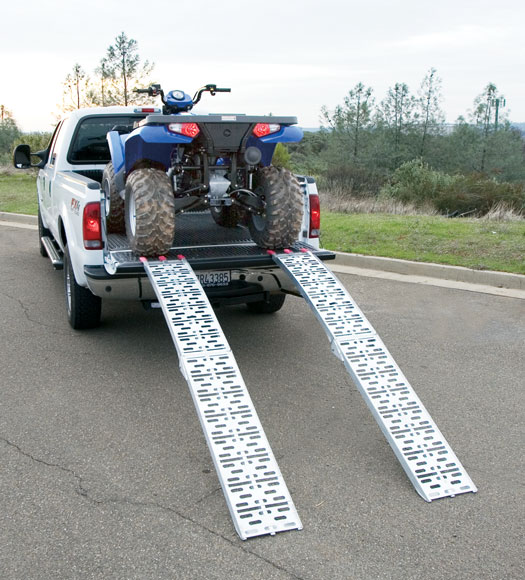 My house as a kid had a nice irrigation ditch in the front that worked well as we could drive an ATV from the yard right into the bed of a truck that had been backed into the ditch. To use this method, just follow these easy steps.
My house as a kid had a nice irrigation ditch in the front that worked well as we could drive an ATV from the yard right into the bed of a truck that had been backed into the ditch. To use this method, just follow these easy steps.
Something to keep in mind, if you have an elevated surface that doesn’t reach high enough for you to drive the ATV into the truck bed, is that you can use the method above to lift your ATV into the truck bed from an elevated position and it will make it a whole lot easier on your knees, arms and back.
How to Unload without RampsUnloading an ATV without a ramp is a little scary the first time you try it, but it is really easy and fast.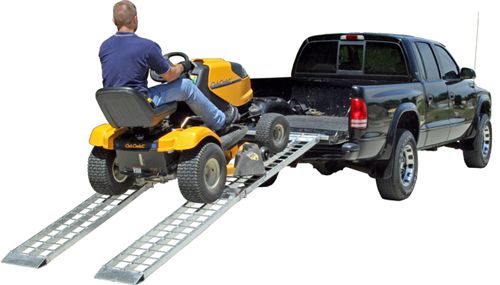 Once again, the lighter your ATV, the easier this is going to be. Just pull it from the back grab bar. Pull it straight back, holding up the back end until the front tires reach the end of the truck bed. Then give it a little jerk so the front end clears the tailgate. Prepare yourself for a little bounce backward when the tires hit the ground.
Once again, the lighter your ATV, the easier this is going to be. Just pull it from the back grab bar. Pull it straight back, holding up the back end until the front tires reach the end of the truck bed. Then give it a little jerk so the front end clears the tailgate. Prepare yourself for a little bounce backward when the tires hit the ground.
Yes, you still should have ramps and use them whenever possible. Ramps are going to be the safest and easiest way to load an unload an ATV, and should be useable in any conditions.
Picking the right ATV ramps is not an easy task as it is going to depend a bit on your personal preferences and your hauling vehicle. Some people swear by a single piece ramp (as opposed to two tracks). These tend to be a bit safer and easier to use and are great for beginners. I personally don’t love them because they tend to be a little steeper and bulkier. Here is an example of a great tri-fold single piece ramp as an example.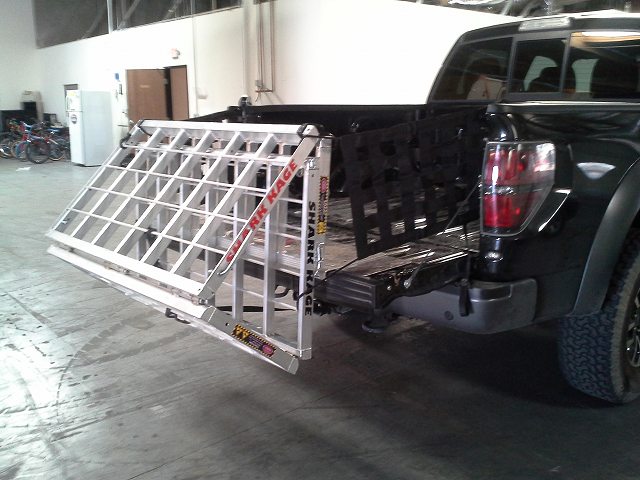
I personally prefer the ramps in our recommended gear because they are a bit cheaper, very sturdy and have arches so it easy to drive the ATV into the truck bed without accidently gassing it into the rear window of the truck.
Some considerations to keep in mind as you are buying and using ramps are below.
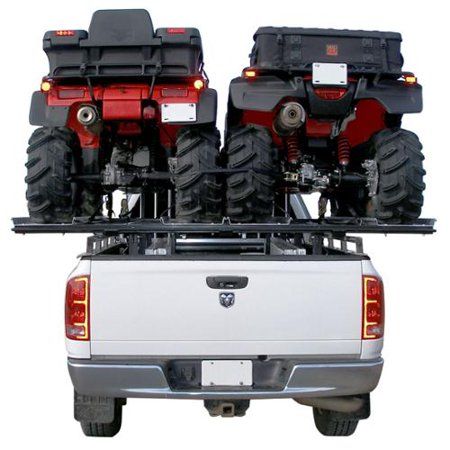
That’s it. There really isn’t much to loading an ATV, but it probably leads to nearly as many accidents as actually riding. Get some ramps and follow these tips, but don’t despair if you don’t have ramps. You can easily load the ATV even without ramps. Just make sure to do so safely.
My New Favorite Accessory for Winter Riding
Over the past several months, as the weather has gotten cooler, I have been testing out the Venustas Heated Vest for my cold-weather photography.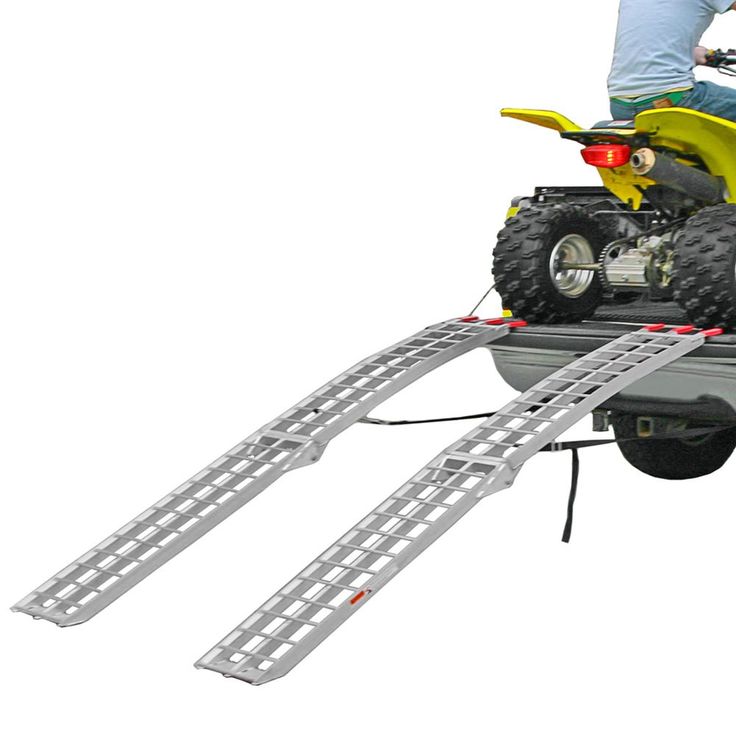 I wrote all about it over at Photography &...
I wrote all about it over at Photography &...
Continue Reading
link to How To Use An ATV SpreaderHow To Use An ATV Spreader
One of the greatest things about summer is yard work. As the heat and humidity rise, so do the plants and flowers. The advent of technology has made seeding and fertilizing, a job that used to...
Continue Reading
For owners of ATVs who need to transport their quad to another location, the most common method is to either use a sufficiently sized pickup truck bed or to load the ATV into a trailer.
Of course, for the transportation process to go safely and smoothly, one must understand how to safely load the ATV first so it is secure during transportation.
Here’s a quick overview of the process of loading an ATV into a truck bed or trailer.
7' 10" Bi-Fold ATV RampThe majority of trailers will either have ramps attached or be low enough to the ground where you can easily purchase and use a small ramp that will allow you to safely load an ATV.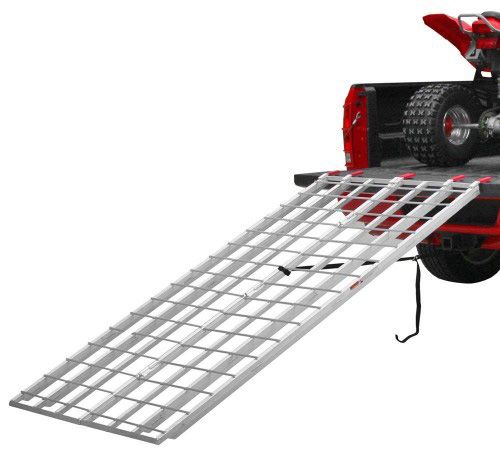 But regardless of whether you’re using a trailer or the back of a truck, the most important thing is to make sure you a) have a ramp meant for the job and b) properly secure that ramp in position.
But regardless of whether you’re using a trailer or the back of a truck, the most important thing is to make sure you a) have a ramp meant for the job and b) properly secure that ramp in position.
Ramps can be a potential safety hazard if they are not secured properly. If you do not have straps or another method of connecting them to the truck or trailer, they could slip off while you try to load the ATV, which could cause significant damage and injury.
6' 8" Tri-Fold ATV RampOnce your ramp is set up for safe loading, make sure you position the quad so you are lined up straight with the ramps. A crooked alignment with the quad could result in you flying right off the side of the ramps before you’re loaded.
Give it a little distance. Get about five to 10 feet back from the ramps and push the quad forward without turning the wheel. If the quad moves forward straight, you have a good alignment and can proceed.
6' 2" Extra-Wide Tri-Fold ATV RampHere’s the part that requires precision, patience and control.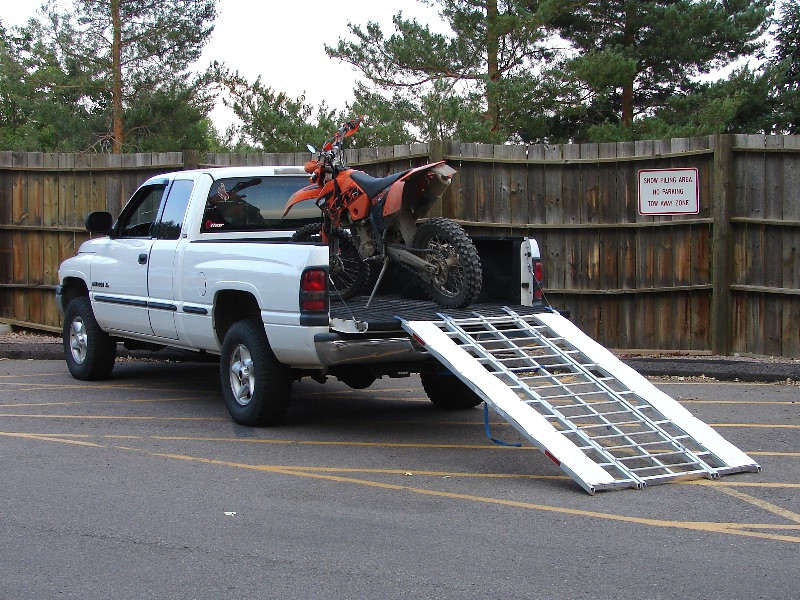
Although you can load an ATV manually by pushing in up the ramp into your truck or trailer, the fastest way to load it is by carefully riding up at a controlled speed. This is why having your loading ramps completely secured to a metal part of the vehicle's frame is critical - if they aren't properly secured, there's a risk that they'll kick out or slip while you're on the ATV mid-ramp. That spells disaster for your ATV, for you, and possibly for any bystanders who could be hit by any of the fallout.
We always recommend having a spotter when loading any powersport vehicle. Not only is it a good safety practice in the event of a loading accident, they can provide a second set of eyes to make sure that your wheels are properly aligned with the ramps and that you're loading straight.
Although hard to do, keeping the ATV going at a controlled, steady speed up the ramp minimizes the amount of time you're on the ramp, and reduces the risk of something going on. By taking the time up front to set up properly, you can roll right on up and keep the jerky start-stop motion at bay.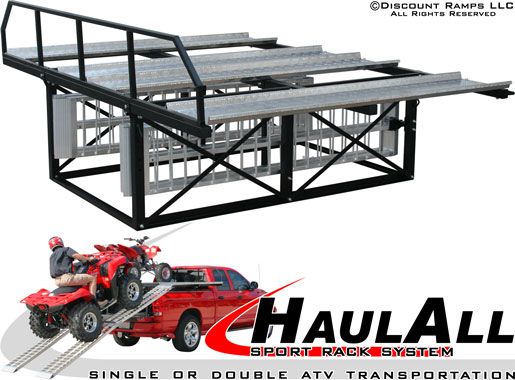
You’re not done once the ATV is in the trailer or truck bed. The next step is to secure it so it does not move around while being transported.
To accomplish this you’ll need a set of high-quality ratchet straps. Strap the front of the quad around the handlebars and keep the ends hooked in around the front tire inside the truck bed or trailer. This will provide enough forward and downward tension to prevent the ATV from bumping and moving during transportation. The second strap will then pass through the grab bar and down to the rear wheel, where it will provide slight tension down and to the back, preventing the back from bouncing during transportation.
Before you go anywhere, make sure you grab on to the handlebars and give the ATV some pushing and pulling. It shouldn’t move or wiggle at all. If it does, you’ll need to increase the tension and/or potentially add another strap so you can better keep the quad in place.
Follow these steps and you’ll be able to safely transport your ATV wherever and whenever you need without a whole lot of extra equipment necessary!
K. Zakurdaev
It was created exclusively for sports and entertainment, but he still won the right to work! The favorite toy of wealthy idlers and resourceful businessmen - an ATV, aka ATV, aka ATV - was conceived two decades ago solely as a "cooler" analogue of a motocross motorcycle for dashing off-road rides. But over the years, this vehicle has found its place among commercial vehicles, gradually turning into almost a real truck!
It was bound to happen. The process took almost twenty years, but the most useless wheeled vehicle in terms of transporting goods still found its place among commercial vehicles. Until recently, this seemed impossible, but today cargo versions of all-terrain vehicles are in the production program of the most famous manufacturers.
What is an ATV? By and large, this is a motorcycle put on four wheels, which has retained its typical fit and exceptional individuality of use, but has gained the ability to overcome the most difficult off-road conditions. The latter quality turned out to be so significant that it was emphasized in one of the names of the ATV - ATV, an abbreviation resulting from the reduction of the words “All Terrain Vehicle”, which literally translates into Russian as “all-terrain vehicle”. And this is one hundred percent true - hardly any other wheeled vehicle will be able to compete on equal terms with an ATV in cross-country ability!
Initially the ATV was conceived exclusively for entertainment The first ones are made as light as possible, with a drive only to the rear wheels (using a chain drive) without any luggage compartments, with two-stroke engines and a rigid suspension. Utility, they are also tourist, models are more practical and comfortable, their design traditionally uses an all-wheel drive transmission, a fully independent suspension, more flexible four-stroke engines.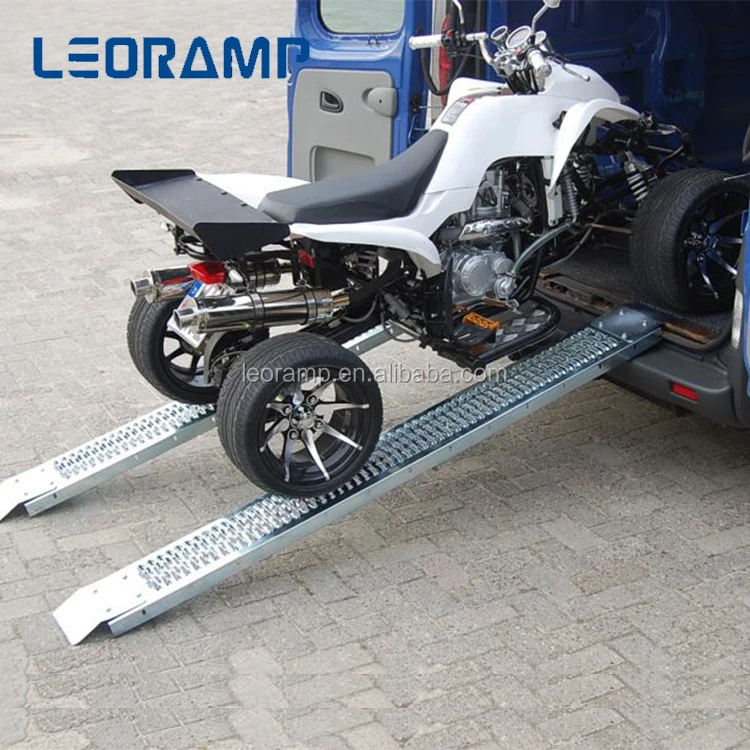 Such ATVs have increased carrying capacity and cargo capacity (due to the use of rear and sometimes front trunks), due to the possibility of transporting a trailer. Needless to say, commercial versions of all-terrain vehicles appeared precisely on the basis of the latter. Such ATVs have increased carrying capacity and cargo capacity (due to the use of rear and sometimes front trunks), due to the possibility of transporting a trailer. Needless to say, commercial versions of all-terrain vehicles appeared precisely on the basis of the latter. At first, the ATV harnessed to work did not differ much from the usual one: all kinds of luggage boxes were installed in the front and rear parts of its body, as well as special holders, with which it was possible to securely fix shovels, ladders and other tools. Since the ATV was not originally intended to carry any significant amount of cargo, special trailers were used, which dealers began to offer a great variety as accessories.
: the first - because of the small usable volume, the second - because of the inconvenience of using in difficult off-road conditions, so a cardinal solution to the issue of cargo capacity was required. Polaris was the first to cut the Gordian knot. Taking as a basis the heavy utilitarian-tourist model Sportsman, the designers mounted a cargo platform in its rear part. True, due to the short base of the vehicle, an additional axle had to be “rolled up” under it, as a result of which the car turned out to be six-wheeled. Such an ATV could already carry about 360 kg of cargo, which is about three times more than a conventional model is capable of transporting, and the cargo could be indivisible, it did not need to be pushed into different trunks and containers. But the price for the increased cargo capacity was increased weight and fuel consumption, worsened dynamics and maneuverability. In addition, the ATV, as it was, remained single-seat, which is not very good for any commercial transportation. In a word, new constructive solutions were required, at least partially removing these problems. And they were found.
So the ATV, adapted for the transport of goods, did not escape common features with it. How useful are ATV trucks? It depends. Of course, ordinary carriers do not need them. The operation of commercial versions of all-terrain vehicles is possible only in rather specific conditions where the use of traditional trucks, such as pickups, is impossible or unprofitable. Cargo versions of ATVs are bought thanks to the qualities inherited from the "ancestors". First, they have off-road capabilities that the vast majority of four-wheel-drive pickups or larger off-road trucks are not capable of.
especially manifested in difficult road conditions, in which it is more economically profitable to transport small loads on it. This is true for all kinds of maintenance or consumer service companies, and for individuals who purchase an ATV-truck for their personal use. You can even say that in today's life, cargo versions of all-terrain vehicles have come to the place of "jeeps" of the middle of the last century - the most simplified utilitarian off-road vehicles, designed to constantly be "on the hook": either to throw people to the right place, or a small load, and all this is out of reach. How much can an ATV carry on its shoulders? A little - from three hundred to five hundred kilograms, as the Polaris Ranger or Yamaha Rhino models already mentioned above. But practice shows that for the range of tasks in which cargo versions of ATVs are involved, this is quite enough. Plus, it is possible to tow a trailer of about the same mass. But it can be predicted that in the future the carrying capacity, and most importantly, the carrying capacity of all-terrain vehicles will grow. Confirming this trend is the recent introduction of the three-axle version of the Polaris Ranger with a payload capacity of almost 600 kg, as well as an extended version of the Yamaha Pro Hauler model, which is more like a full-fledged commercial truck, from which to light pickup is literally one step away! Please enable JavaScript to view the comments powered by Disqus. 5 tips + 4 bonus ❗️ SKOGGYThe 21st century can be safely called an office one. Especially the last 5 years. More and more remote work appears, more and more specialties related to the IT sphere appear. And this means that people need not only more pants to wipe them on the office chair, but also more active forms of recreation, so as not to grow roots in the floor of the office or their own home. One of the most actively gaining popularity types of recreation is quad biking. It is good because it will suit absolutely everyone: both lovers of easy walks in the forest or the coast, and those who crave thrills in impenetrable mountains, deserted fields and swamps.
If this is going to be your first ATV, then you can start with simple budget models, since you still won’t feel the difference now. And in order to spend a minimum of time on the purchase, keep five important tips for buying a quadric without a headache. ATV used or new? This is important to decide well before you buy.
First, the dealer always gives a guarantee. This will save you from problems in the event of a breakdown - you just drive the ATV to the service and experienced specialists will fix all the problems.
Secondly, an inexperienced quad rider will not be able to identify serious flaws or recognize technique after drowning. Water is not the best companion for any transport and, in most cases, it is necessary to change the engine or transmission, and this is exactly half the price of the entire “pony”.
Thirdly, when you ride a certain amount of time and understand what you lack in a quadric and decide to buy a more powerful or comfortable one, it will be much easier to sell your predecessor. Equipment that had only one owner flies under the hammer much faster than the one that was in the hands of two or three people. ATV or ATV SSV? ATV .
SSV . Two- / four-seater with a cabin similar to a car. Inside: there are seats, a round steering wheel, a wide dashboard. The long wheelbase of such all-terrain vehicles increases stability and controllability at high speeds, the load capacity is much higher - up to 400 kg. But such quads will not be so maneuverable and are more like a full-fledged off-road car.
The choice depends on your goal: whether it will be solo “rides” or whether you are ready to take passengers on board for joint entertainment. Which ATV manufacturer would you prefer? Obviously, the leaders in the production of equipment are the Japanese.
Canadian BRP technology has become very popular in recent years. Over the 70 years of their existence, they have learned to make vehicles equipped with literally everything. And each new model is becoming more and more perfect vehicle, capable of surviving in literally any conditions.
American Polaris is also a quality, hard-working brand. The engines have high traction performance and a degree of safety.
In recent years, many Chinese manufacturers have appeared on the market, attracting with their price. Despite the fact that China is advancing and improving quite quickly in the production of any goods, nevertheless, it is still inferior in quality to top brands. What are the main performance characteristics of an ATV?When choosing a good ATV, pay attention to the main performance characteristics, namely: Engine size. For hunting, fishing, sports, driving on a dirt road, 150-230 cm3 will be enough. To dive into extreme tourism, you should choose a powerful engine of 350-689 cm3. Power. For light riding or training, 13-15 hp will be enough for you. If the plans are full-fledged trips through the endless impassability of our Motherland (and we mean mountains and forests, not cities in the middle zone), then you should put a pony with a capacity of up to 45 horsepower in a stall. It is horse, not pony. Transmission. Mechanical - suitable for moving on more or less flat roads, as it requires attention when switching gears. CVT - suitable for hunting or fishing, where in manual mode it is necessary to switch gears only in loose areas or when encountering obstacles. Automatic gearbox. She controls the speeds depending on the engine speed and road conditions. You can focus entirely on the route or immerse yourself in the performance of a sports stunt. Cooling system. You should not allow the engine to overheat, which means you need to choose the right cooling system for your needs. The air type is suitable for lighter fishing or hunting trips, for example. If everything is hardcore for you, then it is better to choose a fluid system that will provide the quadric with more heat transfer, and you will have peace of mind during extreme recreation.
The purpose of purchasing the ATV Well, the last but the main advice. Before choosing an ATV, think carefully for what purpose you need it: sports, walking or extreme riding. It depends on the amount you invest. Better yet, first rent an ATV a couple of times and understand whether you will ride it from time to time or whether you claim to be a quadro-maniac. In this case, of course, it is worth buying your own transport, but you also need to approach the choice more carefully - you will need more than five tips.
And if you do not want to delve into the intricacies of choice and want to immediately get a good ATV that meets your needs, then you can always turn to specially trained people who, for some fee, are engaged in the selection of auto and motorcycle transport. As a rule, these are well-versed people who know the design of an ATV, have information about new products and have all the necessary technical means that can identify all the shortcomings of a vending instance. ATV GarageBut whatever your goal when buying an ATV, be prepared to shell out a tidy sum for the transport itself, accessories, gear and storage space. If you have a small one-car garage, then it is worth considering an alternative shelter for the ATV, where it will live quietly and not interfere with you during your daily use of the car.
A garage 3-4 meters long is suitable for an ATV. As with any vehicle, the roof and walls must be airtight. In order for it to serve you for more than one year, you should pay attention to iron garages. The collapsible design will allow you to move the garage from place to place, unless of course there is a need for this. You never know, suddenly you decide to move on your ATV to another house. You can take the garage with you. Yes, and if you are planning a rearrangement on your site, a couple of hours - and the garage is dismantled. We rested, decided on a new place, another hour or two - and the garage for the ATV is already in a new place. You can choose a collapsible garage design from profiled sheets, or you can choose a frame one. In the second case, the garage is also collapsible, but the frame is assembled before sheathing with corrugated board. Gates can be made ordinary swing or use roller shutters. It is possible to install a gate in any part of the garage. And for connoisseurs of the coolness of not only an ATV, but also its keeper, you can apply the most brutal print.
Helpful Hints
|